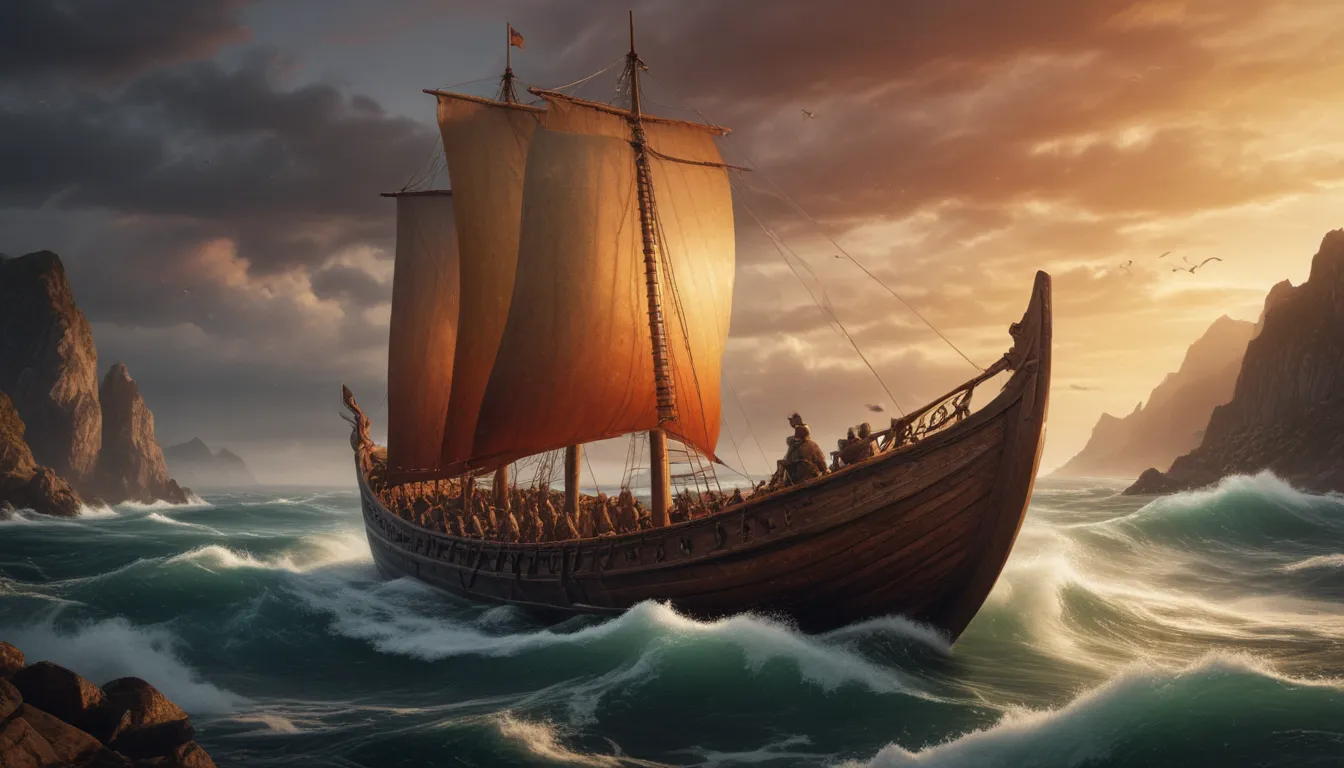The images in our articles may not match the content exactly. They are used to grab your attention, not to show the exact details in the text. The images complement the text but do not replace it.
Are you intrigued by the ancient prowess of the Vikings, who traversed vast distances with their awe-inspiring ships long before modern exploration? Embark on a journey through time to explore the wonders of Viking ships, the ultimate vessels of the Viking Age. From their innovative design to their lasting legacy, discover the secrets that made these ships a symbol of power and craftsmanship. Let’s set sail into history and delve into 23 incredible facts about Viking ships that will leave you amazed and enlightened.
Unraveling the Wonders of Viking Ships
Viking ships were not just modes of transportation; they were masterpieces of ancient engineering that enabled the Norsemen to navigate treacherous waters, conduct raids, and explore distant lands. Let’s uncover what made these vessels so extraordinary:
-
Design: The clinker-built construction of Viking ships, with overlapping wooden planks, provided strength and flexibility, allowing them to withstand the rigors of the open sea.
-
Sails and Oars: Equipped with a single large square sail and the ability to be rowed, Viking ships possessed both speed and maneuverability, essential for their diverse maritime activities.
-
Shallow Draft: With a shallow draft, these ships could navigate shallow rivers and land directly on beaches, surprising their foes with their strategic advantage.
Diverse Types of Viking Ships
The Vikings crafted various types of ships, each tailored for specific purposes such as warfare, trade, or exploration. Let’s explore the distinct characteristics of these remarkable vessels:
-
Longships: Sleek, narrow, and swift, longships were the warships of the Viking fleet, accommodating up to 60 warriors and adorned with shields along their sides.
-
Knarrs: As cargo ships, knarrs were broader and deeper than longships, designed for long sea voyages loaded with goods or settlers to new lands.
-
Dragonheads: Elaborately carved prows shaped like dragons or serpents served as protective figureheads on Viking ships, symbolizing power and warding off spirits.
The Craftsmanship Behind Viking Ship Construction
The Vikings were skilled artisans who meticulously crafted their ships using natural resources and ingenious methods. Let’s delve into the craftsmanship involved in constructing these legendary vessels:
-
Wood Selection: Oak, known for its durability, was the preferred material for Viking shipbuilding. The Vikings selected curved trees that matched the hull’s shape, showcasing their resourcefulness.
-
Tools of the Trade: Axes, adzes, and chisels were the primary tools used by Viking shipbuilders, highlighting the precision and expertise required for creating these intricate vessels.
-
Tar Waterproofing: To ensure their ships were watertight, Vikings utilized tar made from pine or birch bark, preserving the wood and enhancing the longevity of their maritime expeditions.
Ancient Navigation Techniques of the Vikings
In an era devoid of modern navigational aids, the Vikings relied on the sun, stars, and natural landmarks to guide their ships through uncharted waters. Let’s uncover their innovative methods of navigation:
-
Sun Compass: A wooden disk used to determine the ship’s course by observing the shadow cast by the sun, showcasing the Vikings’ ingenuity in utilizing natural elements for navigation.
-
Ravens as Guides: Legend has it that Vikings released ravens to gauge the proximity of land; if a raven returned, land was distant, offering a unique avian perspective on navigation.
-
Celestial Navigation: By leveraging knowledge of coastal landmarks and star positions, the Vikings honed their navigational skills, enabling them to undertake daring sea voyages with remarkable precision.
Enduring Legacy of Viking Ships
The influence of Viking ships transcends time, shaping maritime history, cultural heritage, and linguistic traditions across generations. Let’s explore the enduring legacy of these legendary vessels:
-
Archaeological Discoveries: Well-preserved Viking ships unearthed from burial mounds offer insights into ancient shipbuilding techniques and the seafaring lifestyle of the Norse people.
-
Cultural Significance: Viking ships symbolize the spirit of adventure and conquest, permeating modern culture through literature, movies, festivals, and museum exhibits, keeping their legacy alive.
-
Innovative Shipbuilding Techniques: The design principles of Viking ships, such as the clinker-built method and keel stability, have influenced shipbuilding practices for centuries, showcasing their lasting impact.
-
Historical Navigation: Vikings’ advanced navigational prowess enabled them to reach North America long before other European explorers, underscoring their maritime achievements.
-
Replica Voyages: Modern replicas of Viking ships, crossing the Atlantic and studying ancient seafaring techniques, highlight the enduring seaworthiness and historical significance of these vessels.
-
UNESCO Recognition: Designated as UNESCO World Heritage Sites, some Viking ship finds are preserved for future generations, preserving a tangible link to the past for educational purposes.
-
Language Influence: Terms like “keel over” and “on board” trace their origins to the Viking Age, showcasing the linguistic impact of Viking seafaring on contemporary English language usage.
-
Educational Value: Viking ships feature prominently in school curricula worldwide, educating students about exploration, innovation, and cultural exchange throughout history.
-
Tourist Attractions: Museums dedicated to Viking ships, such as the Viking Ship Museum in Oslo, attract visitors eager to experience firsthand the magnificence of these ancient vessels.
-
Maritime Celebrations: Annual festivals celebrating Viking culture with ship replicas, reenactments, and traditional crafts foster community engagement and appreciation for Norse heritage.
-
Global Maritime Influence: The legacy of Viking ships extends beyond Scandinavia, influencing maritime traditions and shipbuilding practices worldwide, showcasing the enduring impact of Viking innovation.
Charting a Course through Viking Ship History
As we navigate the rich tapestry of Viking ship history, we unravel the tales of seafaring prowess, craftsmanship, and exploration woven into the legacy of these legendary vessels. From the intricate carvings on their prows to the technological advancements that propelled them across the seas, Viking ships continue to captivate our imagination and inspire a sense of wonder. As we bid farewell to this maritime odyssey, let us carry with us the spirit of adventure and discovery embodied by the Vikings, reminding us that the echoes of their epic voyages still reverberate through the annals of history.
Anchoring Trust in Authenticity
At the core of our commitment to delivering enlightening and reliable content lies a dedication to authenticity and accuracy. Each fact presented on our platform is contributed by real users, meticulously reviewed by our editors to ensure credibility and trustworthiness. We invite you to embark on a journey of exploration and learning with us, confident in the integrity and quality of the information we provide. Embrace the wealth of knowledge before you, crafted with care and precision to enlighten and inspire your quest for understanding.






